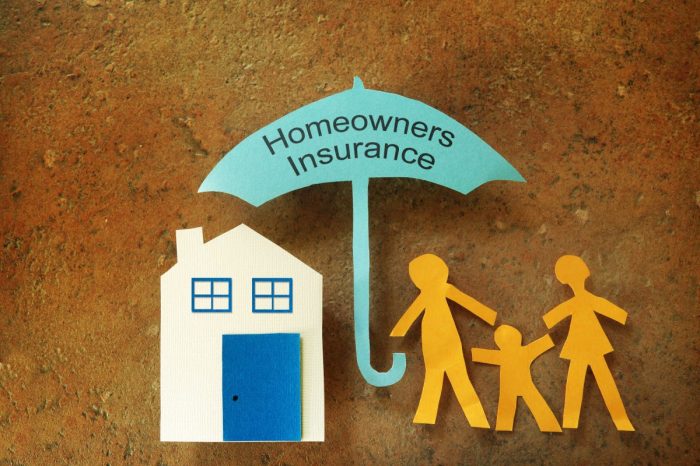When it comes to safeguarding your most valuable asset, homeowners insurance plays a crucial role in providing financial protection and peace of mind. Let’s delve into the world of homeowners insurance and explore its various aspects.
From understanding the importance of coverage to navigating the claims process, this comprehensive guide will equip you with the knowledge you need to make informed decisions about protecting your home.
Importance of Homeowners Insurance
Homeowners insurance is a crucial financial safety net for homeowners, providing protection and peace of mind in the face of unforeseen events.
Protection for Property
Homeowners insurance safeguards your property against damage or loss caused by events like fire, theft, vandalism, or natural disasters. In the event of such incidents, the insurance covers the cost of repairs or replacement, ensuring that you don’t have to bear the financial burden alone.
Liability Coverage
In addition to property protection, homeowners insurance also offers liability coverage. This means that if someone is injured on your property or if you accidentally damage someone else’s property, the insurance can help cover legal fees and medical expenses, protecting you from potential lawsuits.
Additional Living Expenses
Another valuable aspect of homeowners insurance is coverage for additional living expenses. In case your home becomes uninhabitable due to a covered event, the insurance can help pay for temporary lodging, meals, and other necessary expenses until your home is repaired or rebuilt.
Example Scenarios:
- Imagine a scenario where a fire breaks out in your kitchen, causing extensive damage. Without homeowners insurance, you would have to bear the entire cost of repairs, which could be financially devastating. But with insurance, you can file a claim and have the necessary funds to restore your home.
- Another example could be a situation where a guest slips and falls on your icy driveway during winter. Without liability coverage, you might be held responsible for their medical bills and legal fees. However, homeowners insurance can step in to cover these costs, protecting your finances.
Types of Coverage
When it comes to homeowners insurance, there are different types of coverage available to protect your property and belongings in various situations. It’s essential to understand the differences between standard coverage and optional coverage to ensure you have the right level of protection.
Standard Coverage
Standard coverage typically includes protection for your dwelling, other structures on your property, personal property, liability coverage, and additional living expenses in case your home becomes uninhabitable due to a covered loss. This is the basic level of coverage that most homeowners insurance policies offer.
- Your Dwelling: This covers the structure of your home, including walls, roof, foundation, and built-in appliances, in case of damage from covered perils like fire, theft, or vandalism.
- Other Structures: This provides coverage for structures on your property that are not attached to your home, such as a detached garage, shed, or fence.
- Personal Property: This protects your belongings inside your home, like furniture, clothing, and electronics, if they are damaged or stolen.
- Liability Coverage: This helps cover legal expenses and medical bills if someone is injured on your property and you are found liable.
- Additional Living Expenses: If your home is uninhabitable due to a covered loss, this coverage helps pay for temporary living arrangements, like a hotel or rental property.
Optional Coverage
Optional coverage allows you to customize your policy with additional protection for specific risks that may not be covered under standard homeowners insurance.
- Flood Insurance: Protects your home and belongings from flood damage, which is typically not covered by standard homeowners insurance.
- Earthquake Insurance: Covers damage to your home caused by earthquakes, a peril that is often excluded from standard policies.
- Scheduled Personal Property: Provides coverage for high-value items like jewelry, art, or collectibles that exceed the limits of your standard personal property coverage.
- Home Business Coverage: If you run a business from your home, this coverage can protect your business equipment and liability risks.
Factors Affecting Premiums

When it comes to homeowners insurance premiums, several factors come into play that can influence the cost of coverage. Understanding these factors is essential for homeowners looking to secure the best insurance policy for their needs.
Location
- The location of your home plays a significant role in determining your insurance premium. Homes located in areas prone to natural disasters such as hurricanes, earthquakes, or wildfires may have higher premiums due to the increased risk of damage.
- Additionally, the proximity to fire stations, crime rates in the neighborhood, and even the availability of local repair services can impact insurance costs.
Home Value
- The value of your home is another crucial factor that affects your insurance premium. Higher home values typically mean higher replacement costs, which can result in higher premiums.
- It’s important to regularly reassess the value of your home to ensure you have adequate coverage without overpaying for insurance.
Deductible Choices
- Your deductible amount, which is the out-of-pocket expense you agree to pay before your insurance coverage kicks in, can impact your premium rates.
- Choosing a higher deductible can lower your premiums, but it also means you’ll have to pay more in case of a claim. On the other hand, a lower deductible will result in higher premiums.
Home Security Measures
- Investing in home security measures such as alarms, security cameras, and deadbolt locks can potentially lower your insurance costs.
- Insurance companies often offer discounts for homes with security systems in place, as they reduce the risk of burglary and vandalism.
Filing a Claim
When it comes to filing a homeowners insurance claim, it is important to follow the necessary steps to ensure a smooth process and successful outcome. From documenting the damage to communicating with your insurance company, each step plays a crucial role in getting the compensation you deserve.
Steps Involved in Filing a Homeowners Insurance Claim
- Contact your insurance company as soon as possible to report the damage or loss.
- Provide detailed information about the incident, including the date, time, and cause of the damage.
- Document the damage by taking photos or videos to support your claim.
- Prepare a list of all damaged or lost items, along with their value and any receipts or proof of purchase.
- Cooperate with the insurance adjuster during the inspection and assessment of the damage.
- Review and understand your policy coverage to know what is included in your claim.
Documentation Needed When Filing a Claim
- Copies of your homeowners insurance policy.
- Photos or videos of the damage or loss.
- Receipts or proof of purchase for damaged or lost items.
- Police reports (if applicable).
- Any communication with the insurance company regarding the claim.
Tips for a Smooth and Successful Claims Process
- Report the damage promptly to your insurance company.
- Keep detailed records of all communication and documentation related to the claim.
- Follow up with your insurance company to ensure your claim is being processed in a timely manner.
- Stay organized and provide all requested information to expedite the claims process.
- Ask questions and seek clarification if you are unsure about any aspect of the claim process.
Understanding Policy Exclusions

When it comes to homeowners insurance policies, it’s crucial to understand what is not covered to avoid any surprises during a claim. Policy exclusions Artikel specific situations or items that are not eligible for coverage under a standard policy.
Common Exclusions in Homeowners Insurance Policies
- Earthquakes and floods are typically not covered under a standard homeowners insurance policy. If you live in an area prone to these natural disasters, you may need to purchase separate coverage.
- Normal wear and tear, as well as maintenance-related issues, are usually excluded from coverage. It’s important to properly maintain your home to prevent these issues.
- Home business-related liabilities and damages are often not covered under a standard policy. If you run a business from home, you may need additional coverage.
Examples of Situations where Coverage may be Denied
- If your home suffers damage due to a flood, but you do not have a separate flood insurance policy, your claim may be denied.
- If a tree falls on your property due to lack of maintenance and damages your roof, the repairs may not be covered by your homeowners insurance.
- If a client visiting your home for business purposes gets injured, the liability may not be covered under a standard homeowners policy.
Additional Coverages and Riders
When it comes to homeowners insurance, there are additional coverages and riders that can be added to policies to provide extra protection and peace of mind. These options can help homeowners tailor their coverage to better suit their individual needs and circumstances.
Flood Insurance
- One important additional coverage that homeowners may consider is flood insurance.
- This coverage protects against damage caused by flooding, which is typically not covered under standard homeowners insurance policies.
- Especially for homeowners living in flood-prone areas, adding flood insurance can be crucial to safeguarding their property.
Scheduled Personal Property Coverage
- Another valuable rider to consider is scheduled personal property coverage.
- This allows homeowners to specifically list high-value items such as jewelry, fine art, or collectibles and ensure they are adequately covered in case of loss or damage.
- By adding this coverage, homeowners can have peace of mind knowing their most valuable possessions are protected.
Earthquake Insurance
- For homeowners in earthquake-prone regions, earthquake insurance is a recommended additional coverage.
- This policy can help cover the cost of repairs or rebuilding in the event of earthquake damage, which is typically excluded from standard homeowners insurance.
- Given the potential for significant financial loss in the event of an earthquake, this coverage can be a wise investment for homeowners in vulnerable areas.
Home Inventory and Documentation
Creating a home inventory is crucial for insurance purposes as it helps you accurately assess the value of your belongings in case of theft, damage, or loss. This documentation ensures that you receive proper compensation for your items.
Importance of Home Inventory
- Start by listing all your possessions, including furniture, electronics, appliances, jewelry, and other valuable items.
- Include details such as purchase dates, prices, and serial numbers to provide proof of ownership.
- Take photographs or videos of each item and store them securely along with your inventory list.
Documenting Belongings
- Organize your inventory by room or category to make it easier to update and access when needed.
- Consider using home inventory apps or software to streamline the process and keep your information up-to-date.
- Keep receipts, appraisals, and other relevant documents in a safe place, such as a fireproof box or a secure cloud storage.
Organizing and Storing Inventory Information Securely
- Make copies of your inventory list and store them in a separate location to ensure redundancy in case of emergencies.
- Encrypt digital files and use strong passwords to protect sensitive information from unauthorized access.
- Regularly update your inventory to reflect any new purchases or changes in the value of your belongings.
Closing Notes
As we wrap up our discussion on homeowners insurance, remember that being prepared is key to handling unforeseen circumstances. By grasping the intricacies of your policy and taking necessary steps to safeguard your home, you can rest assured that your investment is well-protected.